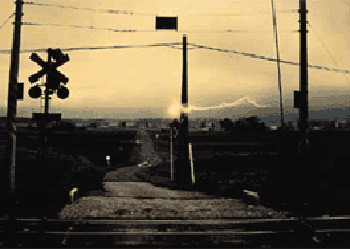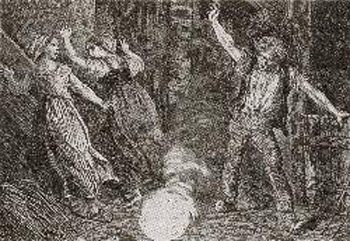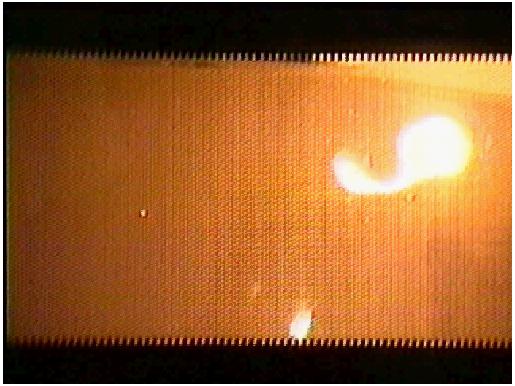ball lightning

A possible example of ball lightning.

Ball lightning from Flammarion's L'atmosphère.

Plasma ball inside a microwave oven.
Ball lightning is one of the strangest and least understood weather phenomena. Seemingly a close cousin of earthlights, or earthquake lights, though with some distinctive properties of its own, ball lightning crops up in the most unexpected places. In a letter to the journal Nature physicist Richard Jennison gave this remarkable eyewitness account:
I was seated near the front of the passenger cabin of an all-metal airliner (Eastern Airlines Flight EA 539) on a late night flight from New York to Washington. The aircraft encountered an electrical storm during which it was enveloped in a sudden bright and loud electrical discharge (0005h EST, 19 March 1963). Some seconds after this, a glowing sphere a little more than 20 centimeters in diameter emerged from the pilot's cabin and passed down the aisle of the aircraft approximately 50 centimeters from me, maintaining the same height and course for the whole distance over which it could be observed.
Jennings went on to say that it was blue-white in color, gave off no heat as far as he could tell and glided along at walking pace about two-and-a-half feet from the floor.
Ball lighting in a plane
Another account of strange goings-on aboard an airliner was issued by the TASS news agency. It described how a ball of fire, four inches across, appeared on the fuselage in front of the cockpit of an Ilyushin-18 aircraft as it flew close to a thunderstorm over the Black Sea on 15 January 1984. According to the report:
It disappeared with a deafening noise, but re-emerged several seconds later in the passengers' lounge, after piercing in an uncanny way through the air-tight metal wall. The fireball slowly flew over the heads of the stunned passengers. In the tail section of the airliner it divided into two flowing crescents which then joined together again and left the plane almost noiselessly.
The radar and some other instruments aboard the Ilyushin were damaged and two holes were later found in the fuselage. The "deafening crash" and damage to the aircraft could have been caused by ordinary lightning but this certainly wouldn't account for the appearance of the glowing sphere inside.
Domestic sightings
Ball lightning has been reported in a great variety of places by many different kinds of people. It's surprisingly common and a quick survey of one's own family and friends will usually elicit a crop of recollections on the subject. One of my grandmother's favorite tales was of the time a bright, fiery ball came down the chimney of her home, floated silently around, apparently carefully avoiding every object in its path, and finally escaped after she opened the back door to let it out! A more traumatic experience was described by a woman from Smethwick, England. During a heavy summer thunderstorm in 1975, a luminous sphere, bright blue to purple in color and with a flame-like halo, appeared over her gas stove. The 4-in ball, which gave off a rattling noise and singeing smell, advanced toward the woman who tried to brush it away. Almost immediately, it exploded with a bang leaving her with a reddened and swollen hand, and a 4½- by 2½-inch hole in her dress. This was therefore one of the few well-documented cases of ball lightning having left behind any tangible evidence.
Another domestic sighting gives some idea of the variety of forms that ball lightning can take:
On March 23, 1977, we had a heavy, stormy day in the Cape ending with a short, sharp thunderstorm during the late afternoon. At 2.50 a.m. (March 24) some hours after the passing of the storm, I was awakened by a sharp "s-s-s-spht" and to my amazement saw a small "ball of fire," about 2½ to 3 inches in diameter, with a comet-like tail some 12 to 15 inches long, traveling north to south ... about 2 feet away from the center of a heavy double wardrobe, with quite heavy brass fittings and about the same distance from the floor and some couple of yards from my bed, the whole thing only lasting seconds - all a bit frightening and very surprising... The two sides of double French windows were open a few inches, apparently it was through one of these that this phenomenon made its way, or did it just materialize inside the room? I should add that my Labrador dog, asleep on the landing, appeared instantly in the doorway at the sound of the "s-s-s-spht" - and I imagine he saw the thing from his puzzled look."
Some researchers have argued that such sightings of luminous balls can be explained in terms of unusual manifestations of lightning or other familiar electrical effects. However, such attempts to relegate ball lightning to the level of the mundane aren't at all convincing. Whatever it is, it's been seen by too many well-qualified observers, including the likes of world-class scientists Niels Bohr, Victor Weisskopf, and Martin Ryle, as well as pilots and other professional eyewitnesses, to be easily dismissed. Moreover, its appearance and behavior are totally unlike anything else we routinely come across in nature.
Characteristics of ball lighting
A typical ball is 4½ to 9 inch in diameter (with a maximum range between about half an inch and three feet) and glows most commonly red, orange, or yellow in color, though occasionally blue or white, with about the brightness of a domestic electric light. It may have a halo around it, emit sparks or rays, and survive for anything up to several minutes before disappearing, either suddenly in an explosion or by gradually fading away. Odors resembling ozone, burning sulfur, or nitrogen oxide are sometimes referred to, occasionally with the presence of a faint mist or residue. Rarely do the objects cause significant damage. One exception was in 1936 when, according to a correspondent to a British newspaper, during a thunderstorm, he saw a large "red-hot" ball, the size of an orange, come down from the sky, strike a house, cut a telephone wire, burn a window frame and then submerge itself in a four-gallon tub of water which subsequently boiled for several minutes. This dramatic finale allowed a back-of-envelope estimate to be made of the object's energy density. It turned out to be about half that of an equivalent volume of molten iron.
The movement of the balls is one of their most interesting and puzzling features. Typically, it's horizontal with a speed that seems completely independent of local air currents. Many balls are described as spinning. A curious ability to navigate around obstacles is another characteristic, although some balls show an affinity for metal objects and may move along conductors such as wires or metal fences as if they were rails. Others appear to be able to pass, ghost-like, through closed doors and windows with ease. Among their favorite reported haunts are chimneys, fireplaces, and stoves.
Most sightings are made during thundery weather and are usually associated with lightning. Sometimes, the link is compelling, as in this account by a Dr. E. M Galton:
A few years ago, sitting at noon in our window in Glion over Lake Geneva, my wife and I watched a heavy thunderstorm slowly crossing the lake. When it reached the north shore, an intense flash of forked lightning was followed by the appearance, apparently a few hundred feet above the ground, of a ball the color an size of the sun at noon. The edges were slightly fuzzy, It was about three miles away and drifted with a smooth, non-rotating motion like a balloon for about a half-mile possibly at right-angles to the wind direction, until it settled on the top of either a telegraph pole or a gantry connected with the railway, and vanished. We both saw the ball and are certain that it was not an after-image caused by the lightning-strike.
The appearance of ball lightning, however, is by no means always associated with lightning strikes, and fair-weather balls are not unknown. This prompts the question of whether the balls are indeed some kind of by-product of electrical activity in the atmosphere or have a more exotic origin.
Theories of ball lighting
In the early 1970s, a group of physicists at the National Center for Atmospheric Research in Boulder, Colorado, suggested that thunderstorms could act like enormous particle accelerators. Protons whipped up to high energy would, according to the theory, induce nuclear reactions by smashing into atomic nuclei in the air. The result would be radioactive isotopes of oxygen and fluorine, which, as they decayed with the emission of positrons and gamma rays, could supply the energy for ball lightning. To test their idea, the Boulder team examined various objects that had been in the vicinity of recent appearances of ball lightning for traces of residual radiation – but found none.
An even more radical suggestion came in 1971 from two scientists at the Culham and Harwell Laboratories of the UK Atomic Energy Authority. David Ashby and Colin Whitehead decided to set up a gamma-ray detector and leave it working for several months to see if it would pick up any unusual surges of radiation. It did - four of them. And, remarkably, one of the surges, in which the level of radiation rose to fifty times that of the background level for a few seconds, coincided with a severe thunderstorm. The surges of radiation could not be matched with the pattern that would be expected from radioactive nuclei. So, the physicists came up with an even more intriguing proposal. The gamma-ray bursts, they said, might be coming from antimatter meteorites!
Antimatter does exist. It was first predicted by the English physicist Paul Dirac in 1929. Particles of antimatter – antiprotons, antielectrons (positrons), and so on – are routinely produced in accelerators. And, recently, clusters of anti-atoms have been created for fractions of a second in the laboratory. But it's always been an open question as to whether large chunks of antimatter exist in nature. In the 1950s and '60s, cosmologists debated if the contents of the universe were more or less equally divided between matter and antimatter. Were there antimatter planets, antimatter stars, and even entire antimatter galaxies? The trouble is we'd never be able to tell simply by looking at them, because the light they gave off would be indistinguishable from the light from objects made of ordinary matter. Only when antimatter came into contact with matter would the truth be revealed, because then the two would completely annihilate and disappear in a puff – or a devastating bang – of gamma-rays.
Ashby and Whitehead proposed that ball lightning was caused by tiny grains of antimatter. These grains, they suggested, arrived from space and slowly filtered down through Earth's atmosphere, shielded from immediate annihilation by a kind of quantum barrier. The grains would tend to become negatively charged through the emission of positrons and so would be drawn to the ground as it became positively charged during thunderstorms. It's a fascinating theory and one that has never been experimentally ruled out, though most researchers today would regard it as a long shot.
Ball lighting in the lab
The likelihood remains that ball lightning is some kind of esoteric electromagnetic effect – a sphere of ionized gas, or plasma, held together by electric and magnetic fields. If so, then it ought to be possible to recreate it under laboratory conditions. There's certainly been no shortage of attempts to do this. Among the earliest were by the talented but eccentric scientist, Nikola Tesla. A Yugoslav emigre to the United States, Tesla was something of an enigma. In the late nineteenth century he pioneered a number of electrical inventions, including the Tesla coil, but never swam in the scientific mainstream. He gave extraordinary performances, as much magic shows as public lectures, involving high voltage devices, sparks, and, purportedly, floating, glowing balls.
Did Tesla create artificial ball lightning? So secretive were his researches that we'll probably never know. But effects strongly reminiscent of ball lightning have turned up under other artificial circumstances, such as this one described by Eunice Overend of Frome, Somerset, England:
I was fiddling with a faulty hair-dryer and inadvertently touched the live wires from one terminal to the half-case of metal so that the motor spun for an instant as the insulation melted. A beautiful blue bubble, about 2 inches across, appeared above it, and then floated down. It vanished as it touched the cloth, but left a hole like that of a cigarette burn.
What special conditions are needed to produce such an effect? Is there a reliable recipe for making ball lightning in the home or in the laboratory? Several cases are on record of fireballs being created inadvertently inside American submarines. In 1974, the Philadelphia Naval Shipyard was carrying out circuit-breaking tests on the switch gear of the USS Cutlass. Two generators onboard the vessel charged two sets of batteries through a circuit-breaker made of copper and silver. Technicians had installed reverse-current relay in order to isolate the contacts of the circuit-breaker in the event that current from a charged battery started to flow through a generator that wasn't operating. When such short circuits did occur, an arc appeared between the silver contacts of the circuit-breaker and the engineers saw a glowing green ball floating away from the contacts into the surrounding area.
More recent attempts to create effects similar to ball lightning have met with mixed success. One popular theory, dating back to the 1950s, is that ball lightning is a plasma discharge caused by the interference of radio waves. To test this idea, a group of Japanese scientists, in 1991, used a device similar to a microwave oven in which they set up standing waves. As a result, they observed several different types of plasma discharge including moving flames and stationary balls. Interestingly, one plasma fire, varying in color from white or blue to red and orange, could be made to pass through a ceramic board three millimeters thick without damaging the board. In a variation on this basic experiment, the physicists used a 4-inch-long copper bar in the microwave cavity. This produced many plasma balls, one after another, which traveled along the bar, even when a strong wind was blown on them.
Fortunately, the Japanese researchers managed to avoid the fate of a certain Dr. Richmann of St. Petersburg. In a famous incident in 1753, Richmann had connected a lightning conductor to an electrometer in his laboratory, with the intention of measuring how much charge a lightning strike could pack. However, the hapless experimenter discovered the truth more directly: his apparatus generated a blue-white globe the size of a man's fist which leapt up and killed him on the spot.
Ball lightning has amazed and, sometimes literally, stunned people over the centuries. It's evidently a real physical phenomenon and one that isn't particularly uncommon. Yet its nature remains a genuine enigma – a problem for twenty-first century science.
Postscript: Ball lighting associated with a meteor?
On the evening of 23 September 2005, about 7:30 pm, at least 20 people along the northeast coast of Florida reported having seen a bright light streaking across the sky. An off-duty police officer from Palm Bay was among the first. "He said it looked like a huge flaming ball that went off into the horizon," said a Coast Guard officer in Port Canaveral. Other calls came in to Coast Guard stations from Jacksonville to Fort Pierce. According to a NASA scientist the object was mostly likely a fragment of an asteroid. An account of the phenomenon appeared in the Orlando Sentinel on 25 September.
One eyewitness to the event, Patricia Bishop of Orlando, reported to this website having seen not only the meteor but what appears to be an example of ball lighting shortly after. She writes:
I saw the same type of object falling from the sky near Orlando Intl Airport before I saw the ball. To be more detailed, the ball traveled slowly through the woods (my backyard backs up to a small wooded area). It was moving horizontally, traveling from north to south in a perfectly straight line. [There was] no noise... [I]t was about 50 yards away [and] approximately 12 feet off the ground. It was perfectly round, reddish-orange, and flashed a bright white light every few seconds (like a camera flash).
Two things were strange about it: It traveled like it was underwater, as if our atmosphere was too thick for it, [and] even though it was moving through a wooded area in a perfectly straight line it never changed shape, as if it never touched any of the trees even though it couldn't possibly have avoided one without changing direction. My time line was around 8:30 for the meteorite and 8:50–9:00 for the ball.


